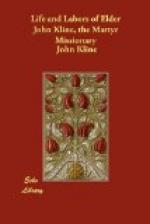SUNDAY, September 30. Attend the burial of William Hevner’s son Harvey. He died of typhoid fever. His age was twenty-seven years, two months and four days. It has been a very short while since his sister Elizabeth passed away. We should weep with those who weep: but our deepest sympathy for others cannot give us a realization of the depth of grief felt by bereaved parents and their children. Happy are those who can look beyond the tomb to have their sorrows healed.
Between this time and the close of the year Brother Kline made only one long journey. He and Anna went in his family carriage to Maryland first. After attending a number of love feasts and other meetings around Frederic City and Shepherdstown, they went down the Cumberland Valley beyond Harrisburg, and after a few days’ sojourn there they return by very nearly the same route they went. They were just three weeks and two days on this journey.
END OF 1849.
Whole distance traveled this year by me is 3,903 miles.
SUNDAY, February 12, 1850. Meeting at Buck Hill, in Shenandoah County, Virginia. I speak from John 6:44, 45. TEXT.—“No man can come to me, except the Father which hath sent me draw him.”
I here note the substance of what I said. My text sets forth the two great facts which all should know: man’s weakness and God’s power. The first part of the text declares man’s absolute weakness in himself and of himself. In another place our Lord says: “Without me ye can do nothing.” In the text he says: “No man can come to me.” Had he stopped here we would be left without hope. But he did not stop here. Immediately, as if by the same breath of love, he adds: “Except the Father which hath sent me draw him.” This part shows that if the Father does draw a man he can come to Jesus. Now, then, does the Father draw? The prophets say he does in these words: “And they shall all be taught of God.” He draws them by teaching them. In what follows we may learn the power of this Great Teacher. Notice very particularly: “Every man,”—this means every human being, whether man or woman,—“every man therefore that hath heard and hath learned of the Father, cometh unto me.”
But here are things very deep. Our minds inquire to know how the Father, whose voice we have never at any time heard and whose shape we have never seen, can teach us. It is through the Son that the Father speaks, for the Son bears this testimony himself in these words: “I speak not from myself; but the Father which sent me, he hath given me a commandment what I should say and what I should speak. And I know that his commandment is life eternal: the things therefore which I speak, even as the Father hath said unto me, so I speak.” Nothing can be plainer than this that Jesus spoke with authority, the divine authority of the Father, and that he is God the Father manifest in the flesh, the Emmanuel—God




